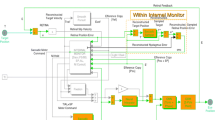Abstract.
The goal of this study was to test whether a superposition model of smooth-pursuit and vestibulo-ocular reflex (VOR) eye movements could account for the stability of gaze that subjects show as they view a stationary target, during head rotations at frequencies that correspond to natural movements. Horizontal smooth-pursuit and the VOR were tested using sinusoidal stimuli with frequencies in the range 1.0–3.5 Hz. During head rotation, subjects viewed a stationary target either directly or through an optical device that required eye movements to be approximately twice the amplitude of head movements in order to maintain foveal vision of the target. The gain of compensatory eye movements during viewing through the optical device was generally greater than during direct viewing or during attempted fixation of the remembered target location in darkness. This suggests that visual factors influence the response, even at high frequencies of head rotation. During viewing through the optical device, the gain of compensatory eye movements declined as a function of the frequency of head rotation (P < 0.001) but, at any particular frequency, there was no correlation with peak head velocity (P > 0.23), peak head acceleration (P > 0.22) or retinal slip speed (P > 0.22). The optimal values of parameters of smooth-pursuit and VOR components of a simple superposition model were estimated in the frequency domain, using the measured responses during head rotation, as each subject viewed the stationary target through the optical device. We then compared the model's prediction of smooth-pursuit gain and phase, at each frequency, with values obtained experimentally. Each subject's pursuit showed lower gain and greater phase lag than the model predicted. Smooth-pursuit performance did not improve significantly if the moving target was a 10 deg × 10 deg Amsler grid, or if sinusoidal oscillation of the target was superimposed on ramp motion. Further, subjects were still able to modulate the gain of compensatory eye movements during pseudo-random head perturbations, making improved predictor performance during visual-vestibular interactions unlikely. We conclude that the increase in gain of eye movements that compensate for head rotations when subjects view, rather than imagine, a stationary target cannot be adequately explained by superposition of VOR and smooth-pursuit signals. Instead, vision may affect VOR performance by determining the context of the behavior.
Similar content being viewed by others
Author information
Authors and Affiliations
Additional information
Received: 16 June 1997 / Accepted: 5 December 1997
Rights and permissions
About this article
Cite this article
Das, V., DiScenna, A., Feltz, A. et al. Tests of a linear model of visual-vestibular interaction using the technique of parameter estimation. Biol Cybern 78, 183–195 (1998). https://doi.org/10.1007/s004220050425
Issue Date:
DOI: https://doi.org/10.1007/s004220050425




